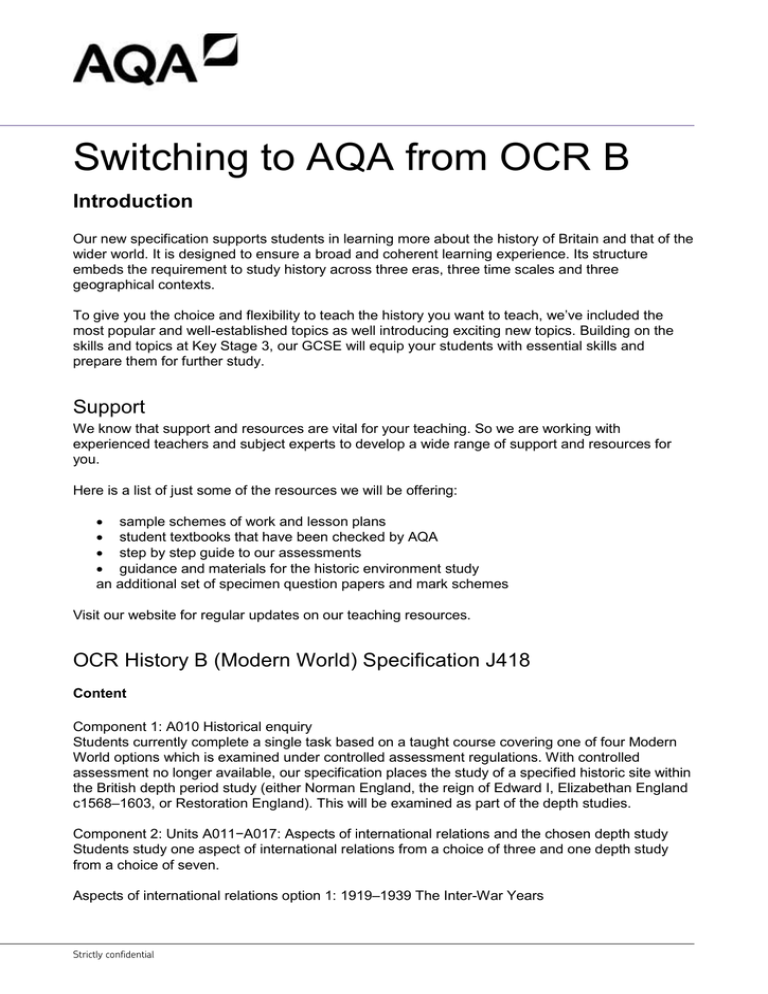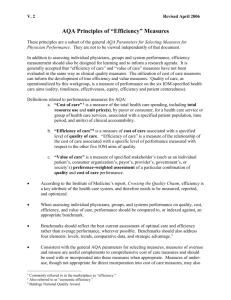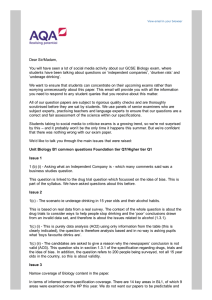GCSE History Guide Switching to AQA from OCR B
advertisement

Switching to AQA from OCR B Introduction Our new specification supports students in learning more about the history of Britain and that of the wider world. It is designed to ensure a broad and coherent learning experience. Its structure embeds the requirement to study history across three eras, three time scales and three geographical contexts. To give you the choice and flexibility to teach the history you want to teach, we’ve included the most popular and well-established topics as well introducing exciting new topics. Building on the skills and topics at Key Stage 3, our GCSE will equip your students with essential skills and prepare them for further study. Support We know that support and resources are vital for your teaching. So we are working with experienced teachers and subject experts to develop a wide range of support and resources for you. Here is a list of just some of the resources we will be offering: sample schemes of work and lesson plans student textbooks that have been checked by AQA step by step guide to our assessments guidance and materials for the historic environment study an additional set of specimen question papers and mark schemes Visit our website for regular updates on our teaching resources. OCR History B (Modern World) Specification J418 Content Component 1: A010 Historical enquiry Students currently complete a single task based on a taught course covering one of four Modern World options which is examined under controlled assessment regulations. With controlled assessment no longer available, our specification places the study of a specified historic site within the British depth period study (either Norman England, the reign of Edward I, Elizabethan England c1568–1603, or Restoration England). This will be examined as part of the depth studies. Component 2: Units A011−A017: Aspects of international relations and the chosen depth study Students study one aspect of international relations from a choice of three and one depth study from a choice of seven. Aspects of international relations option 1: 1919–1939 The Inter-War Years Strictly confidential This topic is covered in AQA’s new wider world depth study: Conflict and tension 1918–1939. Both OCR and AQA cover peacemaking after the First World War, the League of Nations and the collapse of international peace by 1939. Aspects of international relations option 2: 1945–1975 The Cold War Two of OCR’s three key questions in this topic, covering the origins of the Cold War and the Cuban Missile Crisis, are covered in AQA’s new wider world depth study: Conflict and tension between East and West, 1945–1972. Our study, however, goes beyond OCR’s to study events in Hungary and Czechoslovakia, the Soviet response, and the beginnings of Détente. Although this includes reference to OCR’s third key question on the Vietnam War, a more in-depth examination of the war is to be found in our new wider world depth study: Conflict and tension in Asia, 1950-1975. Aspects of international relations option 3: 1948–2005 A New World? This is not covered as a discrete option in AQA’s new specification, but one element is to be found in our wider world depth study: Conflict and tension between East and West, 1945–1972 where events in Hungary and Czechoslovakia and the Soviet response are covered. Our wider world depth study: Conflict and tension, 1990–2009 covers the emergence and reaction to Al-Qaeda as well as the Iraq War, both of which are in this OCR option. The collapse of Soviet control in Eastern Europe and a consideration of other terrorist groups are not covered in the new AQA Specification. A011 Germany 1918−1945 This option is very similar to AQA’s option Germany, 1890–1945: Democracy and dictatorship; however, our study is a study in breadth and not depth. Both cover Weimar Germany, the rise of Hitler and the Nazi Party, the nature of Nazi rule in Germany and what it was like to live in the Nazi state to 1945. The main difference is that our option starts in 1890 and so covers the pre-First World War rule of Kaiser Wilhelm II from a domestic perspective. A012 Russia 1905−1941 This option is covered in AQA’s option Russia, 1894–1945: Tsardom and communism. Our option, however, is broader in focus. Both options deal with the Tsarist regime and its collapse, the Bolshevik takeover and consolidation of power, the establishment and nature of Stalin’s dictatorship, Stalin’s economic policies and the impact they had on the Soviet people. Although our option starts in 1894, rather than 1914, the early content on the nature of Tsarist Russia remains the same for both options. Ending in 1945, rather than 1941, does mean that students will also study the impact of the Second World War on Russia. A013 The USA 1919−1941 This option is covered in AQA’s option America 1920–1973: Opportunity and inequality. AQA’s option has a broader focus and is not a study in depth. Both cover the US economy and society in the 1920s, the consequences of the Wall Street Crash and the Depression, and Roosevelt and the New Deal. The main difference is that our option takes the story on to 1973 and so deals with post war America through topics such as American society, racial tension and Civil Rights campaigns and the ‘Great Society’. A014 Mao’s China c. 1930−1976 This option is not covered in the new AQA Specification. A015 Causes and Events of the First World War 1890−1918 Strictly confidential 2 of 5 This OCR option is covered by the AQA’s wider world depth study: Conflict and tension, 1894– 1918, where the content is very similar. A016 End of Empire c1919−1969 The content of this option is to be found within AQA’s option 2C: Britain: Migration, empires and people, which includes a section on the end of Empire dealing with India, Suez and Kenya. However, as our option is a study in development which covers a long period of time beginning with the Vikings and Anglo-Saxons, the OCR study would look at the end of Empire in greater depth due to the restricted nature of the topic being studied and the relatively short time span involved A017 The USA, Land of Freedom? 1945−1975 Much of the content of this option is covered in AQA's Part 3 (America`s post war society) America, 1920- 1973: Opportunity and inequality. This part deals with McCarthyism, racial tension and the Civil Rights campaigns and women`s rights and ‘liberation’. There are differences; for example, Part 3 of our option also includes more on American society, such as: consumerism, popular culture and the social policies of Presidents Kennedy and Johnson, while the OCR option widens Civil Rights to include Hispanic Americans and Native American Indians. The major difference, however, is that the AQA content is set within a much wider period which starts in 1920. This therefore also covers the US economy and society in the 1920s, the consequences of the Wall Street Crash and the Depression, and Roosevelt and the New Deal – all topics dealt with in OCR`s separate option A013 The USA 1919−1941. Component 3: A021/A022: British depth studies Candidates study one of the following: A021 How was British society changed, 1890–1918? This is not covered as a discrete option in AQA’s new specification but elements of the content can be found in 2A: Britain: health and the people, which includes the work of social reformers such as Booth and Rowntree as well as the Liberal social reforms of the early 20th century. Also elements can be found in 2B: Britain: power and the people, which includes the campaigns for women`s suffrage. Our specification does not include content on aspects of the civilian experience during the Second World War. A022 How far did British society change, 1939–1975? This is not covered as a discrete option in AQA’s new specification but elements of the content can be found in 2B: Britain: power and the people, which includes the development of a multi-racial society since the Second World War and the progress made by women towards equality in the second half of the 20th century. Our specification does not include content on the changing lives of teenagers in the 1960s and 1970s. Structure OCR 3 Components (containing 4 elements) AQA: 2 Components (containing 4 Units) Assessment Strictly confidential 3 of 5 OCR assessment Component 1 A010: Historical enquiry This unit is internally assessed under controlled conditions and is externally moderated. There are 50 marks available (25% of the total) AO weightings: AO1 – 5%: AO2 - 7.5%: AO3 – 12.5% Component 2: Aspects of international relations and the chosen depth study This unit is assessed through a single examination lasting 2 hours. There are 81 marks available (45% of the total), including marks for spelling, punctuation and grammar. Students answer four questions in total – focus on the study in development (in Section A) worth 35 marks, and two on the study in depth (in Section B) worth 40 marks. Each section also contains a compulsory source based question. Students have a choice over their second question in each section. All questions have more than one part. AO weightings: AO1 – 18%: AO2 - 18%: AO3 – 9% Component 3: British depth studies Each option (A021 or A022) is assessed through a single examination lasting 1 hour 30 minutes. There are 53 marks available (30% of the total), including marks for spelling, punctuation and grammar (SPaG). Students answer five questions in total, four of which are source based. AO weightings: AO1 – 12%: AO2 - 6%: AO3 – 12% AQA assessment Component 1: Understanding the modern world has two sections. The total number of marks available is 84 (including 4 marks for spelling, punctuation, grammar and specialist terminology). The time allocated is 1 hour 45 minutes. Section A has a choice of four period studies, each with a focus on two key developments in a country’s history. Students will answer six compulsory questions. Questions 01 to 04 will test AO4. Questions 05 and 06 will test AO1 and AO2. In Section B there is a choice of five wider world depth studies. These focus on international conflict and tension. There are four compulsory questions. The first two questions target AO3. The third and fourth question target AO1 and AO2. Component 2: Shaping the nation has two sections. The total number of marks available is 84 (including 4 marks for spelling, punctuation, grammar and specialist terminology). The time allocated is 1 hour 45 minutes. Section A has a choice of three thematic studies. Each thematic study looks at a key development in Britain over three eras. There are five compulsory questions. Questions 01 and 02 target AO3; Questions 03, 04 and 05 target AO1 and AO2. In Section B there is a choice of four British depth studies. These examine the complexities of a society. The study of the historic environment is embedded. There are four compulsory questions. The first question targets AO4 and relates to the historic environment. The second question also relates to the historic environment but assesses AO1 and AO2. The third and fourth questions relate to the specified historical period and test AO1 and AO2. Strictly confidential 4 of 5 Version (0.2) First published (30/03/2015) Last updated (02/04/2015) Strictly confidential 5 of 5




